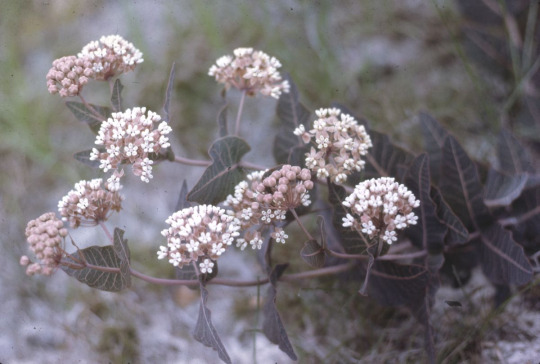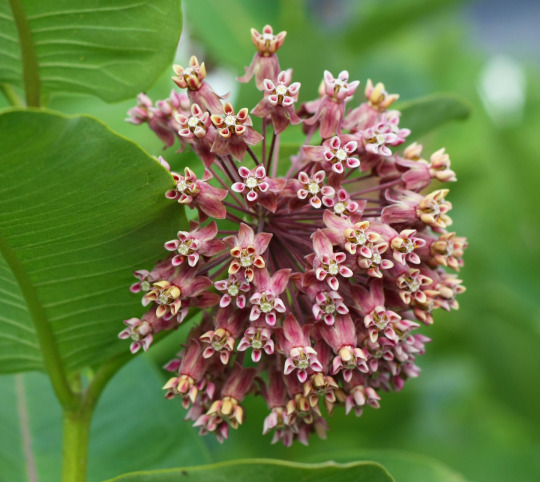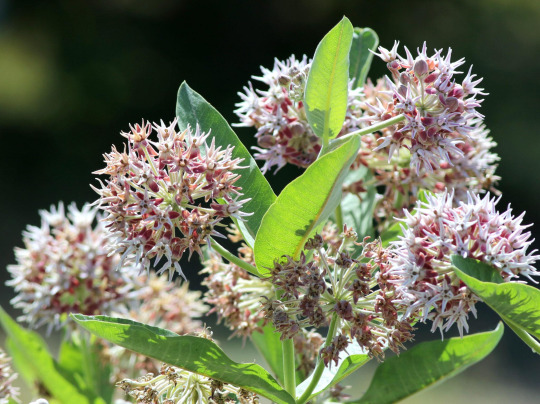#asclepias cordifolia
Text
*cracks knuckles* Alright everyone strap in.
Hi, I'm Ani, the appointed Milkweed Queen of several Discord group chats, and I'm gonna talk about some of my favorite types of milkweed because its Earth Day, I'm bored, and I had nothing else ready to post. Everyone ready?
I'm not going to give these a formal ranking, I'm just going to ramble about them.
We all know the important reasons to like milkweed--supporting Monarchs, feeding the pollinators, restoring native species to your local habitat and creating an environment for many creatures to live in, that's all fantastic obviously. With that established, this ranking system will have little to do with that. We're talking aesthetics, babey! And any fun facts I happen to toss in are, well, fun facts. If you learn about a new kind of milkweed from this, or want to chime in with your own favorites, by all means let me know!

Swamp milkweed (Asclepias incarnata)! If you've been following my blog for awhile, you likely know I've been on a Grand Quest to find, purchase, and/or grow swamp milkweed for a few years now. Honestly, though, who can blame me! Look at those vibrant pink flowers, contrasting with those bright green leaves! Love at first sight, I'm telling you. I've also heard that it smells like vanilla. Vanilla! It's also, reportedly, one of the few types of milkweed that excels in wet environments, and even though my environment isn't very wet, we stan a queen for that quality.

Whether you prefer to call it Sandhill Milkweed or Pinewoods Milkweed, Asclepias humistrata is a champion of sandy soils and also my heart. I hadn't looked too far into this species until late last year, when I was helping another friend look at different milkweeds, but how could I not look into this beautiful plant! With pink stems and veins as early as the seedling stage, pinkish-white flowers and a low-growing spread habit, I would be honored to grow such a specimen in my garden. Their inch-thick, foot-long tap roots help them to quickly spring back to life after a wildfire, providing important food and habitat for creatures returning to the area. How lovely!

Redring milkweed (Asclepias variegata) is another species I hadn't looked too far into until this year, and honestly at great detriment to myself. I'll be honest! I may have ignored this queen at first because I'm not big on white flowers, but those red rings...! Ooh, I want this so bad. The leaves are also fairly big and a lovely dark green, which just makes the white and red pop out more!

Heartleaf milkweed (Asclepias cordifolia) is honestly so iconic, I wish it was native to my region! If you live on the West coast... grow some for me please. How can you not love this specimen! Dusty green heart-shaped leaves directly attached to pink stems, these stunning deep reddish-purple flower clusters...! I continued following one of the most annoying people I'd ever witnessed on Instagram for two months just because I first saw this species in a tiktok of his.

Purple milkweed (Asclepias purparescens) is honestly just. A queen. What else is there to say? Look how purple she is! So purple I almost can't believe it's even real, and yet they are! Not native to my region, far as I know, which is a bummer. I've heard they're hard to grow, but if you can manage it? Share your secrets with the world, honestly, we need more of this plant in our lives.

Common milkweed (Asclepias syriaca) is honestly just a classic. I love the light pink of the flowers, and those leaves are huge! I've heard they spread like wildfire, but with clusters of blooms like this? How can you even be too mad about that?

Showy milkweed (Asclepias speciosa). Honestly I'm not going to pretend I was always crazy about this species, but the more I see it pop up on iNaturalist, the more I find myself growing fond of it. These flowers look like crazy fireworks, and honestly, kinda have to stan.
"Oh, Ani, you have so many lovely favorites! Do you have any least favorite--" Tropical milkweed, hands down. I appreciate it's value as more of a 'babys first milkweed' plant but I'm tired of seeing it everywhere, especially knowing it's a bit invasive in my area?
Anyways, these are some of my favorite milkweed species! What are some of yours?
#milkweed#pollinator gardening#asclepias#asclepias humistrata#asclepias incarnata#asclepias syriaca#asclepias variegata#asclepias cordifolia#asclepias purparescens#asclepias speciosa#swamp milkweed#sandhill milkweed#pinewoods milkweed#redring milkweed#red ring milkweed#heartleaf milkweed#heart leaf milkweed#purple milkweed#common milkweed#showy milkweed#gardening#flowers#pink flowers#purple flowers#white flowers#ani rambles#out of queue#pollinator garden
185 notes
·
View notes
Photo

“Purple Milkweed” by Ferdinand W. Haasis, 1952
Watercolor on paper
To help support the preservation of our collection click here.
#pacific grove#monterey#museum#collection#art#botanical drawing#scientific illustration#purple milkweed#asclepias cordifolia#ferdinand w haasis
29 notes
·
View notes
Text

Asclepias cordifolia
commonly known as Milkweed - from the Apocynaceae family
0 notes
Link
By Melissa McKenzie
It's a startling statistic: The California monarch butterfly population has dropped 86 percent since last year. This was the information provided last month by the Xerces Society, a science-based organization focusing on the conservation, protection and restoration of invertebrate habitats. During the society's annual Western Monarch Thanksgiving count, it was reported there were only 28,429 monarchs in the state.
The count, which was completed in November 2018, had approximately 100 volunteers counting monarchs across 213 sites throughout California. Although some of the loss in butterfly numbers may be attributed to massive wildfires throughout the state last year and climate change affecting the world, the truth is that the monarch butterfly population has been steadily declining since the 1990s.
"In the '90s, a lot of scientists and lovers of monarchs realized the numbers were down, so there has been an effort for the last 25 years to tag the monarchs, try to figure out where they're going, try to get everybody to plant milkweed and track migrations," said Palo Alto Garden Club Conservation member Eleanor Laney, who is one of the leaders of the garden club's Monarch Butterfly Project. The project encourages residents to create butterfly-friendly gardens. Last year, the project successfully released 100 monarchs, which may not seem like a lot, but Laney said that butterfly eggs are "considered caviar" to other insects and only one of every 100 eggs completes its growth cycle to become a butterfly.
Another person doing her part to protect monarch populations is landscape designer Rebecca Schoenenberger, who owns California Nativescapes. As a UC master gardener, Schoenenberger said that there's still much to learn about the monarch butterfly population, and although scientists are still studying this much-loved insect, the decline in population is alarming.
"There are a lot of things we don't know about monarchs," she said. "What we do know is that population counts have dropped dramatically over the last couple of years. There's not really specific evidence pointing to any single factor. It's probably multiple factors as to why that's happening, including pesticide use and habitat loss and destruction. Only certain habitats are protected and there are only a handful of those in California."
There also has been a slight surge in recent years of homeowners installing non-insect-friendly landscapes, which eliminates a food source for monarch butterflies. Another problem, Laney said, is the use of pesticides, particularly those with glyphosate, which kills milkweed plants.
"The problem now is the only thing that the monarch will lay her eggs on is milkweed," said Laney. "If there's no milkweed, there are no monarchs."
To increase the amount of milkweed in people's yards, the Monarch Butterfly Project encourages Palo Alto Garden Club members and their neighbors to plant native milkweed (as opposed to the tropical type) in their gardens in an effort to create a birthing center for monarchs, who die after laying their eggs, and a food source for caterpillars after they hatch.
Both Schoenenberger and Laney are adamant about the need to plant the right kind of milkweed, the native form, rather than non-native strains found in some nurseries, which are toxic to monarchs.
"A big problem is the tropical milkweed," said Schoenenberger. "It's usually what's available at the nursery and often from Mexico. It doesn't go dormant in the winter and will build up a parasite that is deadly to monarchs. It's like junk food or drugs. It builds up with this parasite and the parasite hosts inside the monarch when it's a larvae. It prevents the monarch from growing."
Laney said the tropical milkweed has pretty orange and yellow flowers.
"People love it," she said. "And, the monarchs love it" even though its not good for them.
Laney encourages those who want to plant tropical milkweed to cut it back throughout the winter.
"That way you have cut off all of the potentially infected leaves," she said.
Another important part of a butterfly-friendly landscape are nectar plants, which provide food and energy when monarchs emerge from their cocoons and prepare to continue on their journey north. Ideally, these plants also will be California natives.
"A garden that supports monarchs has nectar plants and native milkweed plants and a couple of types of milkweed," said Laney.
"Milkweed is a nursery plant for the monarch," said Schoenenberger. "It provides food for the caterpillars, and flowers provide food for the butterflies. The numbers are telling us we're at a critical point with the monarchs and our numbers are telling us that we have to do something."
Melissa McKenzie is a freelance writer for the Weekly. She can be emailed at [email protected]
Five ways to attract butterflies to your garden
1 Select your native milkweed. According to the Xerces Society, California native milkweeds include California milkweed (asclepias californica), purple milkweed/heartleaf milkweed (asclepias cordifolia), woollypod milkweed/Indian milkweed (asclepias eriocarpa), narrow-leaved milkweed (asclepias fascicularis), showy milkweed (asclepias speciosa)
2 Plant your milkweed, which is drought tolerant and requires minimal care, in the sun and near nectar plants. Laney believes a minimalist butterfly nursery should contain a minimum of three native milkweed plants and two pollinating plants.
3 When choosing your nectar, Laney recommends the following plants: verbena, clarkia, yarrow, tithonia, California buckwheat and woolly sunflower. Schoenenberger said she keeps zinnias and dahlias in her summer garden because they're big, bright flowers for butterflies to land on.
4 Get your neighbors to plant butterfly-friendly habitat plants to give migrating monarchs more options.
5 Do not use any pesticides, as even organic pesticides can be fatal to butterfly colonies.
0 notes
Photo

Asclepias cordifolia, heart-leaf milkweed
#asclepias#Asclepiadaceae#milkweed#milkweeds#asclepias cordifolia#plants#desert plants#plant#flowering plant#flowers#purple flowers#pink flowers#botany#botanical#fuckyeahbotany
85 notes
·
View notes